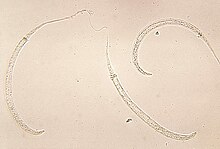Guinea worm
| Guinea worm | |
|---|---|
 |
|
| Scientific classification | |
| Kingdom: | Animalia |
| Phylum: | Nematoda |
| Class: | Secernentea |
| Order: | Camallanida |
| Superfamily: | Dracunculoidea |
| Family: | Dracunculidae |
| Genus: | Dracunculus |
| Species: | D. medinensis |
| Binomial name | |
|
Dracunculus medinensis (Linnaeus, 1758) |
|
| Synonyms | |
|
Gordius medinensis Linnaeus, 1758 |
|
Gordius medinensis Linnaeus, 1758
Dracunculus medinensis or Guinea worm is a nematode that causes dracunculiasis, also known as guinea worm disease. The disease is caused by the female which, at up to 800 mm (31 in) in length, is among the longest nematodes infecting humans. In contrast, the longest recorded male Guinea worm is only 40 mm (1.6 in).
The common name "guinea worm" is derived from the Guinea region of Western Africa.
D. medinensis larvae are found in freshwater, where they are ingested by copepods of the genus Cyclops. Within the copepod, the D. medinensis larvae develop to an infective stage within 14 days. When the infected copepod is ingested by a mammalian host, the copepod is dissolved by stomach acid and the D. medinensis larvae migrate through the wall of the mammalian intestine, and mature into adults. One hundred days after infection, a male and female D. medinensis meet and sexually reproduce within the host tissue. The male dies in the host tissue while the female migrates to the host's subcutaneous tissue. Approximately one year after infection, the female causes the formation of a blister on the skin's surface, generally on the lower extremities, though occasionally on the hand or scrotum. When the blister ruptures, the female slowly emerges over the course of several days or weeks. This causes extreme pain and irritation to the host. When the host submerges the affected body part in water, the female expels thousands of larvae into the water. From here, the larvae infect copepods, continuing the life cycle.
The female guinea worm slowly starts to emerge from the host's skin after the blister ruptures. The most common method for removing the worm involves submerging the affected body part in water to help coax the worm out. The site is then cleaned thoroughly. Then, slight pressure is applied to the worm as it is slowly pulled out of the wound. To avoid breaking the worm, pulling should stop when resistance is met. Full extraction of the female guinea worm usually takes several days. After each day's worth of extraction, the exposed portion of the worm is wrapped around a piece of rolled-up gauze or small stick to maintain tension. This method of wrapping the worm around a stick or gauze is speculated to be the source for the Rod of Asclepius, the symbol of medicine. Once secure, topical antibiotics are applied to affected region to help prevent secondary infections due to bacteria and then is wrapped in gauze to protect the wound. The same steps are repeated each day until the whole worm has been successfully removed from the lesion.
...
Wikipedia
